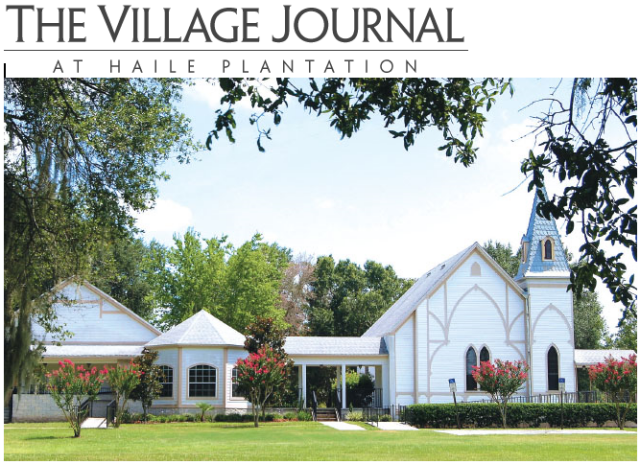
Kanapaha Presbyterian Church
Kanapaha Presbyterian Church: Rooted in History and Relevant for Today
By Kendal Norris 0 Comments
When the Second Seminole War (1835–42) ended, land vacated by exiled Seminoles was cheap and plentiful. That factor, combined with Sea Island cotton crop failures in South Carolina, led to an influx of white settlers and cotton growers in the 1840s and 1850s into what was then known as the Arredondo Grant, much of which is in Alachua County. Among them was Thomas Evans Haile, who paid as little as one dollar an acre for some parcels of his 1500-acre plantation in 1854. He and his wife, Serena, were soon joined by his three brothers, his mother, and two of her brothers. Haile also brought fifty-six enslaved people to work the land; together they harvested the first cotton crop in 1855.
Needing spiritual guidance as well as physical sustenance, a group of planters met together in 1857 to discuss building a permanent Presbyterian church and hiring a pastor for the new congregation. The original Kanapaha (meaning “thatched roof”) Presbyterian Church structure was erected in 1859, and services were led by Reverend William J. McCormick, recruited from South Carolina. It had twelve members and two elders and served its congregants until 1885.
Through the Civil War years, the church building suffered neglect. With even the pastor joining the army as a chaplain, the church was in severe disrepair by the early 1880s. So its members decided to build a new church closer to the recently established Kanapaha railroad station. The stately structure, at its current site near Archer Road and S.W. 75th, was completed in 1886.
Karen Kirkman, president and historian for the Historic Haile Homestead and member of Kanapaha Presbyterian Church commented, “Each Sunday, we ring the original bell cast by Henry McShane & Company of Baltimore, Maryland. Thomas Haile’s youngest son, Carol, born in 1870, was the first person to ring the bell when he was sixteen. We still have the original pews and kerosene chandelier, which we light once a year on Christmas Eve.”
Much that’s known about the church’s history comes from the diary of Serena Haile. It chronicles the laying of the cornerstone, the arrival of the church bell, the dedication ceremony, and the erection of the chandelier throughout the months of 1886.
“As our website says, the beautiful redbordered stained glass windows were purchased with monies earned by selling homemade ice cream from the back of a horse-drawn buggy,” Karen explained. “They remained intact until a tragic act of vandalism in 1972 destroyed them.” She personally spent a great deal of time last year digging around the church’s foundation and managed to find bits and pieces of the original red glass.
In the later nineteenth century, the abolition of slavery, Reconstruction, and the mechanization of agriculture changed the nature of life in north central Florida, shifting it from a rural farming economy, to a city-based/industrialized one. Kanapaha Church membership was depleted in the twentieth century by the two world wars, the Great Depression, the infestation of the boll weevil on cotton crops, and the transition from rural to urban life. The church had to close its doors for a couple of years in the 1940s.
But even a ten-year shift of holding services in another facility closer to Gainesville could not extinguish the spiritual appeal of the original sanctuary. In 1970, a huge renovation project got under way to rehabilitate the structure, eradicate a bee infestation (honey was said to be flowing down the walls from the belfry), and fully refurbish the interior with carpeting, central heat and air, and new electrical wiring. In 2005, the church began a capital campaign to build a larger, more spacious fellowship hall. Memorial Hall, a 3,500 square foot building, was dedicated on June 4, 2006.
“What’s so important about the continuity of Kanapaha Presbyterian is that it is the mother church for all the other Presbyterian congregations in the region,” Karen commented. “Through thick and thin, we have survived and continue to strive to grow as Christians. And we’re deeply involved in community outreach through Habitat for Humanity and Family Promise, a program that provides food and temporary shelter for the homeless.”
Kanapaha also partners with nearby Wesley Chapel United Methodist Church in backpack and shoe giveaway programs, as well as joint hymn singalongs.
The church could be considered progressive in its choice of two female pastors since 1993. The current one, Reverend Dr. Dawn M. Conti, recently earned her doctorate of ministry in preaching. She also conducts a weekly, early morning “Tuesday at Barney’s” Bible study. On September twenty-fifth, Rev. Dr. Conti kicks off a six-week sermon series entitled, “The Road to Abundant Life: The Nuts and Bolts of Living the Christian Life.”
As part of her deep dedication, Karen helps produce the annual Heart, Home and History Tour, which includes the old church cemetery (the site of the original church), the 1886 sanctuary, and reenactments of Serena Haile reading from her diary. On October 30, 2016, an All Saints Day Cemetery Tour is scheduled, featuring firstperson portrayals by descendants of some of the ancestral dead.
Only half a mile from Haile Plantation, and with its close ties to the Historic Haile Homestead, Kanapaha Presbyterian Church remains a place of reverent worship and community service. It’s a strong thread of local tradition weaving the reminder that faith, hope, and charity transcend the often deleterious effects of time.